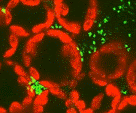Plant Pathology, Department of

Department of Plant Pathology: Faculty Publications
Document Type
Article
Date of this Version
4-2-2019
Citation
The American Phytopathological Society, 2019
Abstract
To increase phenylpropanoid constituents and energy content in the versatile C4 grass sorghum (Sorghum bicolor [L.] Moench), sorghum genes for protiens related to monolignol biosynthesis were overexpressed: SbMyb60 (transcriptional activator), SbPAL (phenylalanine ammonia ase), Bmr2 (4-coumarate: CoA ligase), and SbC3H (coumaroyl shikimate 3-hydroxylase). Overexpression lines were evaluted for responses to stalk pahtogens under greenhouse and field conditions. Greenhouse-grown plants were inoculated with Fusarium thapsinum (Fusarium stalk rot) and Macrophomia phaseolina (charocal rot), which cause yield-reducing diseases. F. thapsinum-inoculated overexpression plants had mean lesion lengths not significantly different than wild-type, except for significantly smaller lesions on two of three SbMyb60 and one of two SbCCoAOMT lines. M. phaseolina-inoculated expression lines had lesions not significantly different from wild-type except one SbPAL line (of two lines studied) with mean lesion lengths significantly larger. Field-grown SbMyb60 and SbCCoAOMT overexpression plants were inoculated with F. thapsinum. Mean lesions of SbMyb60 lines were similar to wild-type, one SbCCoAOMT had larger lesions, whereas the other line was not significantly different than wild-type. Because overexpression of SbMyb60, Bmr2, or SbC3H may not render sorghum more supceptible to stalk rots, these lines may provide sources for development of sorghum with increased phenylpropaniod concentrations.


Comments
Plant Disease 2019 103:2277-2287 https://doi.org/10.1094/10.1094/PDIS-09-18-1622-RE